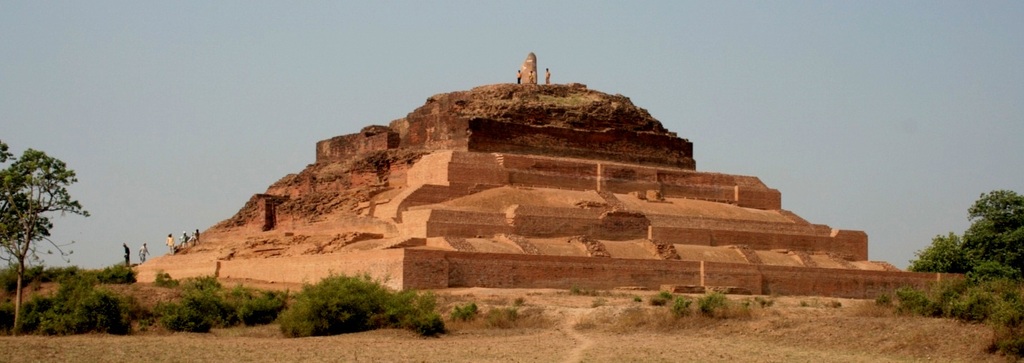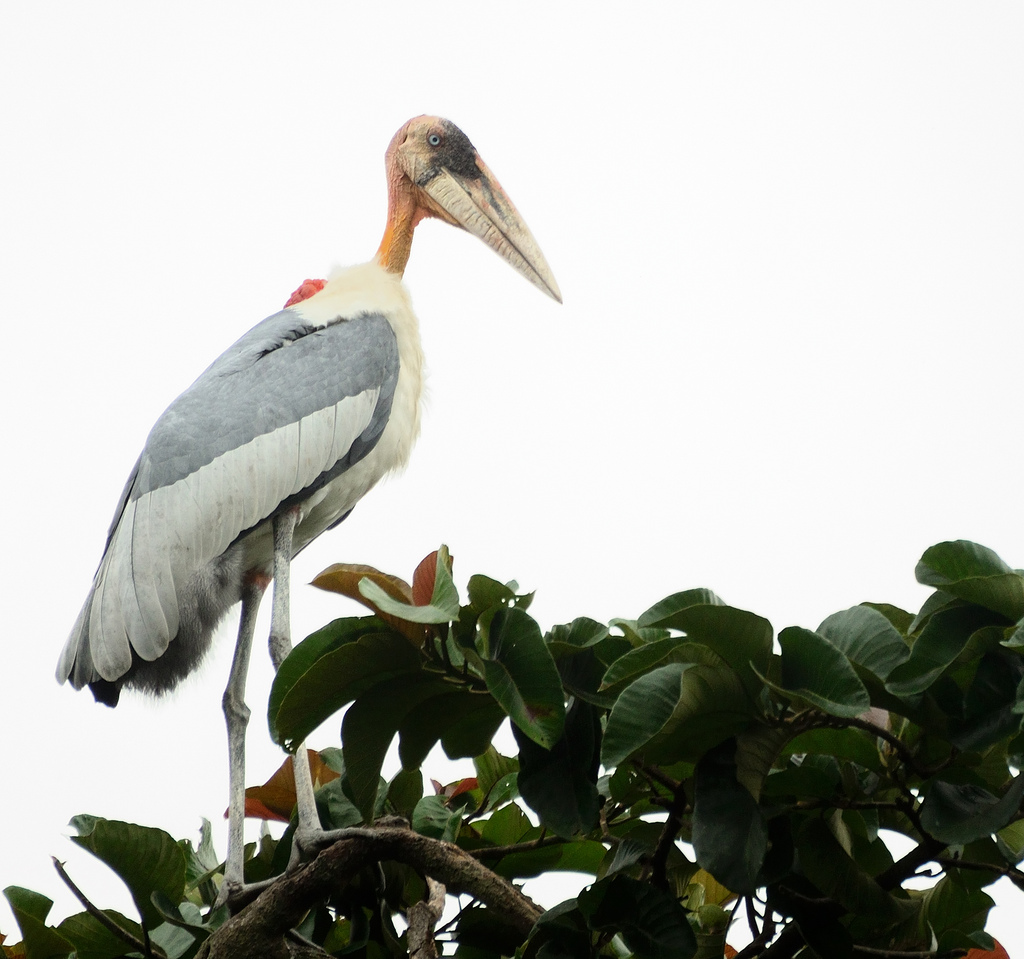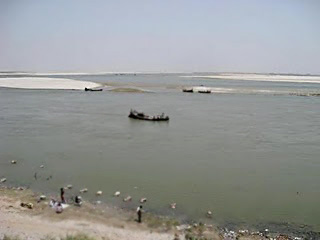|
Anga
Anga (Sanskrit: ) was an ancient Indo-Aryan tribe of eastern South Asia whose existence is attested during the Iron Age. The members of the Aá¹ ga tribe were called the Äá¹ geyas. Counted among the "sixteen great nations" in Buddhist texts like the Anguttara Nikaya, Aá¹ ga also finds mention in the Jain Vyakhyaprajnapti's list of ancient janapadas. Location Aá¹ ga proper was located between the Chandan River, ChampÄ river to the west and the Rajmahal hills to the east. However, at times, its territories did extend to the sea in the south, or included Magadha in the west. The capital of Aá¹ ga, named CampÄ, was located at the confluence of the CampÄ and Ganges, Gaá¹ gÄ rivers, and corresponds to the modern-day villages of Champapuri, CampÄpurÄ« and Champanagar in the eastern part of the Indian state of Bihar, BihÄr. According to the Jataka tales, s, CampÄ was also called KÄla-CampÄ, while Puranas, Puranic texts claim its ancient name was MÄlinÄ«. The other importa ... [...More Info...] [...Related Items...] OR: [Wikipedia] [Google] [Baidu] |
Vanga Kingdom
Vanga was an ancient kingdom and geopolitical division within the Ganges delta in the Indian subcontinent. The kingdom is one of the namesakes of the Bengal region. It was located in southern Bengal, with the core region including present-day southern West Bengal (India) and southwestern Bangladesh. Vanga features prominently in the epics and tales of ancient India as well as in the history of Sri Lanka. Vanga was probably the center of the Gangaridai Empire mentioned by numerous Greco-Roman writers. The exact capital of ancient Vanga kingdom could not be identified. After the rule of Gupta empire, ancient Bengal was divided into two independent states. They were the Gauda Kingdom and Vanga kingdom and archaeologists think that Kotalipara in present-day Bangladesh was the capital of the independent Vanga kingdom. Indian and Greco-Roman writers referred to the region's war elephants. In Indian history, Vanga is notable for its strong navy. There are numerous references to Vang ... [...More Info...] [...Related Items...] OR: [Wikipedia] [Google] [Baidu] |
Brahmadatta Of Anga
Brahmadatta of Anga (6th century BCE) was an ancient Indian King of Anga. Life Brahmadatta was older contemporary to Bimbisara of Magadha. He defeated Bhatiya, father of Bimbisara. After assention to the thrown of Magadha Bimbisara avenged his father's defeat and killed Brahmadatta.The campaign was successful, Anga was annexed, and prince Kunika (Ajatashatru) was appointed governor at Champa See also *Bimbisara *Anga Anga (Sanskrit: ) was an ancient Indo-Aryan tribe of eastern South Asia whose existence is attested during the Iron Age. The members of the Aá¹ ga tribe were called the Äá¹ geyas. Counted among the "sixteen great nations" in Buddhist texts ... References 6th-century BC rulers in Asia {{India-royal-stub ... [...More Info...] [...Related Items...] OR: [Wikipedia] [Google] [Baidu] |
Janapadas
The Janapadas () (c. 1500â600 BCE) were the realms, republics (ganapada) and kingdoms (saamarajya) of the Vedic period on the Indian subcontinent. The Vedic period reaches from the late Bronze Age into the Iron Age: from about 1500 BCE to the 6th century BCE. With the rise of sixteen ''Mahajanapadas'' ("great janapadas"), most of the states were annexed by more powerful neighbours, although some remained independent. Etymology The Sanskrit term ''janapada'' is a tatpurusha compound term, composed of two words: ''janas'' and ''pada''. ''Jana'' means "people" or "subject" (cf. Latin cognate ''genus'', English cognate ''kin''). The word ''pada'' means "foot" (cf. Latin cognate ''pedis''); from its earliest attestation, the word has had a double meaning of "realm, territory" and "subject population" (cf. Hittite ''pedan'', "place"). Linguist George Dunkel compares the Greek ''andrapodon'' "slave", to PIE "fetters" (i.e. "what is attached to the feet"). Sanskrit ''padám'', usu ... [...More Info...] [...Related Items...] OR: [Wikipedia] [Google] [Baidu] |
Magadha
Magadha was a region and one of the sixteen sa, script=Latn, Mahajanapadas, label=none, lit=Great Kingdoms of the Second Urbanization (600â200 BCE) in what is now south Bihar (before expansion) at the eastern Ganges Plain. Magadha was ruled by Brihadratha dynasty, Pradyota dynasty (682â544 BCE), Haryanka dynasty (544â413 BCE), the Shaishunaga dynasty (413â345 BCE) and the Mauryan dynasty by the end of it. Villages had their own assemblies under their local chiefs called ''Gramakas''. Their administrations were divided into executive, judicial, and military functions. Magadha played an important role in the development of Jainism and Buddhism. It was succeeded by four of northern India's greatest empires, the Nanda Empire (c. 345â322 BCE), Maurya Empire (c. 322â185 BCE), Shunga Empire (c. 185â78 BCE) and Gupta Empire (c. 319â550 CE). The Pala Empire also ruled over Magadha and maintained a royal camp in Pataliputra. The Pithipatis of Bodh Gaya referred to ... [...More Info...] [...Related Items...] OR: [Wikipedia] [Google] [Baidu] |
Bhagalpur
Bhagalpur is a city in the Indian state of Bihar, situated on the southern banks of the river Ganges. It is the 2nd largest city of Bihar by population and also the headquarters of Bhagalpur district and Bhagalpur division. Known as the Silk City, it is a major educational, commercial, and political center, and listed for development under the Smart City program, a joint venture between Government and industry. The Gangetic plains surrounding the city are very fertile and the main crops include rice, wheat, maize, barley, and oilseeds. The river is home to the Gangetic dolphin, the ''National Aquatic Animal of India'', and the Vikramshila Gangetic Dolphin Sanctuary is established near the town. The city holds the largest Manasa Puja and one of the largest processions in Kali Puja, an intangible cultural heritage of the region. Demography As of the 2011 India census, the Bhagalpur Urban Agglomeration has a population of 410,210, of which 218,284 were males and 191,926 were f ... [...More Info...] [...Related Items...] OR: [Wikipedia] [Google] [Baidu] |
Bihar
Bihar (; ) is a state in eastern India. It is the 2nd largest state by population in 2019, 12th largest by area of , and 14th largest by GDP in 2021. Bihar borders Uttar Pradesh to its west, Nepal to the north, the northern part of West Bengal to the east, and with Jharkhand to the south. The Bihar plain is split by the river Ganges, which flows from west to east. On 15 November 2000, southern Bihar was ceded to form the new state of Jharkhand. Only 20% of the population of Bihar lives in urban areas as of 2021. Additionally, almost 58% of Biharis are below the age of 25, giving Bihar the highest proportion of young people of any Indian state. The official languages are Hindi and Urdu, although other languages are common, including Maithili, Magahi, Bhojpuri and other Languages of Bihar. In Ancient and Classical India, the area that is now Bihar was considered the centre of political and cultural power and as a haven of learning. From Magadha arose India's first empire, ... [...More Info...] [...Related Items...] OR: [Wikipedia] [Google] [Baidu] |
Jainism
Jainism ( ), also known as Jain Dharma, is an Indian religions, Indian religion. Jainism traces its spiritual ideas and history through the succession of twenty-four tirthankaras (supreme preachers of ''Dharma''), with the first in the current time cycle being Rishabhadeva, whom the tradition holds to have lived millions of years ago, the twenty-third ''tirthankara'' Parshvanatha, whom historians date to the 9th century BCE, and the twenty-fourth ''tirthankara'' MahÄvÄ«ra, Mahavira, around 600 BCE. Jainism is considered to be an eternal ''dharma'' with the ''tirthankaras'' guiding every time cycle of the Jain cosmology, cosmology. The three main pillars of Jainism are ''Ahimsa in Jainism, ahiá¹sÄ'' (non-violence), ''anekÄntavÄda'' (non-absolutism), and ''aparigraha'' (asceticism). Jain monks, after positioning themselves in the sublime state of soul consciousness, take five main vows: ''ahiá¹sÄ'' (non-violence), ''satya'' (truth), ''Achourya, asteya'' (not stealing), ''b ... [...More Info...] [...Related Items...] OR: [Wikipedia] [Google] [Baidu] |
Mahabharata
The ''MahÄbhÄrata'' ( ; sa, महाà¤à¤¾à¤°à¤¤à¤®à¥, ', ) is one of the two major Sanskrit epics of ancient India in Hinduism, the other being the ''RÄmÄyaá¹a''. It narrates the struggle between two groups of cousins in the Kurukshetra War and the fates of the Kaurava and the PÄá¹á¸ava princes and their successors. It also contains philosophical and devotional material, such as a discussion of the four "goals of life" or ''puruá¹£Ärtha'' (12.161). Among the principal works and stories in the ''MahÄbhÄrata'' are the '' Bhagavad Gita'', the story of Damayanti, the story of Shakuntala, the story of Pururava and Urvashi, the story of Savitri and Satyavan, the story of Kacha and Devayani, the story of Rishyasringa and an abbreviated version of the ''RÄmÄyaá¹a'', often considered as works in their own right. Traditionally, the authorship of the ''MahÄbhÄrata'' is attributed to VyÄsa. There have been many attempts to unravel its historical growth and c ... [...More Info...] [...Related Items...] OR: [Wikipedia] [Google] [Baidu] |
Vajjika League
The Vajjika (Pali, PÄli: ) or Vrijika (Sanskrit: ) League, Confederacy, or Sangha, also called simply Vajji (Pali, PÄli: ) or Vriji (Sanskrit: ), was an ancient Indo-Aryan peoples, Indo-Aryan tribal league which existed during the later Iron Age in India, Iron Age period in north-east South Asia. Constituent tribes The Vajjika League were a league of republican tribal states under the leadership of the Licchavi (tribe), Licchavikas centred around the city of Vaishali (ancient city), VesÄlÄ«. The other members of the league were the Videha, Vaidehas in the Mithila (region), Mithila region, the NÄya, NÄyikas (Skt. *JñÄtrika) of Kuá¹á¸apura, and the Vajji (tribe), Vajji tribe proper, who were dependencies of the Licchavikas. The Malla (tribe), Mallakas, who were organised into two separate republics, were also part of the Vajjika League, although they were not dependencies of the Licchavikas and therefore maintained their independence and sovereign rights within the confe ... [...More Info...] [...Related Items...] OR: [Wikipedia] [Google] [Baidu] |
Malinipuri
Malinipuri, also called Malini, is a city mentioned in the Sanskrit epic, the Bhagavad Gita. The city was given to Karna, a warrior and tragic hero of the epic, by Jarasandha, king of Magadha. Karna had sought out weapons instructions but was denied due to his mixed-caste background. He had helped Duryodhana abduct the princess of Kalinga Kalinga may refer to: Geography, linguistics and/or ethnology * Kalinga (historical region), a historical region of India ** Kalinga (Mahabharata), an apocryphal kingdom mentioned in classical Indian literature ** Kalinga script, an ancient writ ... and fought off all the other kings while doing so, including Jarasandha. After this, Jarasandha wanted to test Karna's strength and challenged him to a wrestling match. Karna "ruptured the seam" that held together Jarasandha's body, defeating him, and was given the city of Malini. After this he became "king of the Angas"; it is presumed that Duryodhana elevated Karna to the Anga throne following ... [...More Info...] [...Related Items...] OR: [Wikipedia] [Google] [Baidu] |
Chandan River
The Chandan River flows near the city of Bhagalpur in the state of Bihar, India. It has been identified as probably being the river ''Champa'' on whose banks was located the ancient city of Champa, capital of the Anga mahajanapada. It would have then also been a border between Anga and its neighbour, Magadha Magadha was a region and one of the sixteen sa, script=Latn, Mahajanapadas, label=none, lit=Great Kingdoms of the Second Urbanization (600â200 BCE) in what is now south Bihar (before expansion) at the eastern Ganges Plain. Magadha was ruled .... References Rivers of India {{Bihar-geo-stub ... [...More Info...] [...Related Items...] OR: [Wikipedia] [Google] [Baidu] |
Munger
Munger, formerly spelt as Monghyr, is a twin city and a Municipal Corporation situated in the Indian state of Bihar. It is the administrative headquarters of Munger district and Munger Division. Munger was one of the major cities in Eastern India and undivided Bengal during Mughal period and British Raj. It is one of the major political,cultural,educational and commercial center of Bihar and Eastern India. Munger is situated about 180km from east of capital city Patna, about 480km west of Eastern India's largest city kolkata and 1200km from country's capital New Delhi. Historically, Munger is known for being an ancient seat of rule. The twin city comprises Munger and Jamalpur situated on the southern bank of the river Ganges. It is situated 08 km from Jamalpur Junction,180 km east of capital city Patna and 430 Km from Kolkata the capital of West Bengal. Munger is said to have been founded by the Guptas (4th century CE) and contains a fort that houses the tom ... [...More Info...] [...Related Items...] OR: [Wikipedia] [Google] [Baidu] |
.jpg)

.png)

_1_by_N._A._Naseer.jpg)


